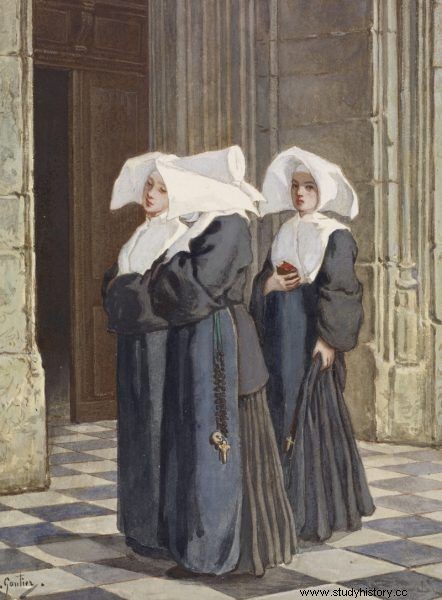A dildo under the bed and girls playing together in the privy? This is what the world of power looked like in the 16th century. And even the most promiscuous poets blushed at the thought of what the queen's courtiers were doing ...
Catherine of Medici came from the Medici family, whose plebeian origin was reproached despite the wealth and influence she had gained. In 1533, she married the future King of France, Henry II Valois. She was 14 at the time. Apparently she loved her husband very much, but he cheated on her with his 20 years older lover, Diana de Poitiers throughout the marriage. . The young wife soon realized that intrigue and betrayal were commonplace in a Parisian palace.
Katarzyna was an alert and suspicious person. In 1574, already as a queen mother, trembling for her and her children's lives, she ordered a thorough search of the Louvre. The alerted guard faced an ambitious task - to search every corner of the palace for hidden weapons.
The phallus affair
The results of the search turned out to be surprising. Katarzyna Medycejska, venting the danger, discovered a sexual scandal! Artificial phalluses of impressive size were found in the chambers of the court ladies.
The owner of the artificial member was, inter alia, Hélène de Surgères, belonging to a respected French family. The beautiful Hélène could not complain about the lack of admirers. One of them was the then poet Pierre de Ronsard, who passionately wrote sonnets for her. The French, however, treated the poet with prosaic indifference.

Did Katarzyna Medycejska have any chances in the competition with Diana de Poitiers? Picture by an unknown representative of the so-called Fontainebleau schools (source:public domain).
There was room in her heart for only one man:a lover who died in battle. Being faithful to his memory, however, did not mean that Hélène was about to give up carnal pleasures. Her actions infuriated Ronsard. The poet decided to take revenge.
But I will not stifle the complaint against her thirsty device. With this thin tail, he fights so every night, looking for a harmful, secluded Love. This is how he wants to drown his sorrows after a lifetime - Ronsard wrote resentfully after he found out what secrets hide his beloved trunks. According to the poet, the fact that the lady uses an artificial phallus was more derogatory than the most daring acts of the courtesans.
Court games without the participation of men
The beautiful Hélène de Surgères was not the only lady at the court of the Louvre to be involved in the dildo scandal. From the descriptions written by Brantôme, a Renaissance chronicler who spent several years at the court of Catherine de Medici, we learn that many seemingly modest and virtuous maidens led an exuberant sex life without the participation of men .

Did any of the ladies in the picture hide a dildo under the bed? A ball at King Henry III's by an unknown author (source:public domain).
One was equipped with a dick tied to the body with soft ribbons, looking almost like a real organ - we read in the book "Forbidden body. A Story of Male Obsession ”by Diane Ducret. The author cites fragments of Brantôme's works, which show that the mansions of Catherine de Medici, equipped with artificial phalluses, were quite inventive.
They made love in various unusual places, e.g. on a piece of furniture that was then used as a toilet bowl. Women lost in delight cooped on it so passionately that the chair broke and one of them - as reported by the chronicler - fell straight into a basin with filth getting dirty on my elaborate gown.
The frightened man quickly ran to her room to change, smelling the smell. The spice of the whole affair was added by the fact that one of the caught red-handed women was a widow and the other was married.
The precursor of pornographic literature, as Brantôme is sometimes jokingly referred to, also recounted a similar story from Toulouse, where in a palace room two eminent ladies , completely tucked up, leaving their pants, lay one on top of another, kissing each other like pigeons, rubbing, wandering around each other, fooling around and pretending to be males.
The nosy chronicler, describing in detail the erotic life of high society, condemned however alien movements and rubbing the uterus . In his opinion, it was immoral and dangerous to health, and could even lead to death. The playful ladies of the French court were also condemned by the queen mother - Catherine de Medici, although she herself, despite the fact that a fervent Catholic (initiated the famous slaughter of the Huguenots on St. Bartholomew's night in August 1572), did not avoid games and debauchery.

Catherine de Medici's mansions were famous for indulging in promiscuous games. The painting by Paul Avril, an erotic literature illustrator, shows the love games of ancient lovers (source:public domain).
In the preface to the Polish edition of "Lives of the playful" by Tadeusz Boy-Żeleński, you can find a description from "The Journal of Henry III", which presents the feast given by Catherine de Medici in honor of her son, Henry (the future king of Poland). The prince's victory at d'Alencon was celebrated at Chenonceau Castle.
The main character of the feta, Henryk, appeared in a female disguise, in a deeply cut outfit that exposed her breasts. The then sixty-year-old Catherine de Medici led an orgy in which her daughter Małgorzata and her daughter-in-law Luiza Lorraine also took part . Half-naked ladies of the court were dressed in men's costumes.

At the age of sixty, Catherine of Medici was leading an orgy with her children? (author:unknown, source:public domain).
Love and Punishment
Lesbian themes were intertwined not only in the history of the Renaissance Louvre. Brantôme also mentioned Margaret of Austria, Duchess of Savoy, who loved the wonderful Laodamia Fortangera in "Lives of the playful ladies" . And the researcher and traveler Leo Africanus wrote in 1526 that the inhabitants of Fez deliberately pretended to be ill in order to use the sexual services provided by the quackers.
In 16th-century Spain, demands were made to deal with women who made love with members of the same sex as with men-sodomites, that is, to burn them at the stake. A similar law was used in Rome. However, there are not many examples of women convicted of lesbian love in the Renaissance.

The article is based, among others, on the book by Diane Ducret, "Forbidden Body. A history of male obsession ”(Znak Horyzont 2016).
In the 1770s, a German city saw the trial of Katherina Hetzedolfer, who was accused of having "had sex" with several other women. According to the testimony of Katherina herself, she used an artificial penis. It was simply a piece of red leather stuffed with cotton and stiffened with a piece of stick. There was a string threaded through the center of this device, which she could tie herself with.
Katherine was plunged into the testimony of witnesses, that is, women who accused her of trying to seduce them or having sex with them, pretending to be a man. A death sentence by drowning was issued in this case.

The monasteries were also affected by Lesbian excesses. In the picture the nuns on the church portal by Armand Gautier (source:public domain).
Lesbian love did not pass by monasteries as well. The Italian nun, Benedetta Carlini, has seduced another nun by persuading her that she is an angel and that everything she does is due to divine intervention.
At the age of thirty, Benedetta began to be plagued by visions. Her superiors feared that she was possessed, so a nun was appointed to stay with her constantly in the same cell. It soon became apparent that the sisters had sex with each other on a regular basis . As punishment, Benedetta spent the rest of her life (35 years) in solitary confinement.
